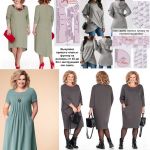 Very often, my subscribers ask something like this about my ready-made patterns:
Very often, my subscribers ask something like this about my ready-made patterns:
Tell me how much fabric is needed for a size 58 dress according to your pattern?
In this article, we will consider methods for calculating (determining) the consumption of fabric for a specific model of clothing according to a finished full-size pattern. And also, ready-made patterns with examples of calculating fabric consumption for them.
Contents:
- Precise determination of fabric consumption according to the finished pattern.
- Approximate consumption of fabric by calculation according to the pattern:
- Calculation of fabric consumption for straight skirts.
- Calculation of fabric consumption for trousers.
- Calculation of fabric consumption for a dress.
- Ready-made patterns with examples of calculating fabric consumption for them.
1. Accurate determination of fabric consumption according to the finished pattern
Make a scale drawing on paper or make life-size patterns and lay out the layout taking into account the seam allowances and the width of the fabric.
That is, if you know the width of the fabric that you will buy, then you can decompose the patterns in width, not exceeding half the width of the fabric, not forgetting about the seam allowances and determine what length of fabric with this width you need!
But, since in the drawing and layout it is sometimes important to take into account not only the exact width of the fabric, but also the pattern and the presence of pile, this method is not always suitable.
If you want to sew a product pile fabric or fabric with a large pattern, ideally, you should lay out the finished patterns according to the life-size pattern on the fabric that you will buy. That is, it is advisable to go to the store for fabric with your own ready-made patterns.
The most common way to calculate fabric consumption remains "mathematical" (let's call it so conditionally). Let's consider it.
2. Approximate consumption of fabric by calculation according to the pattern.
2.1 For straight skirts:
one length + hem, if Sat + Fri less than fabric width minus 10 cm.
2.2 For trousers:
If the trousers are small (Sat no more than 50 cm) and the width of the fabric is 1 m 40 cm, then all the details fit into one length of the trousers.
The consumption is:
pants length + 12 cm.
If the pants are voluminous, add another 20 cm:
db + 12 + 20 cm.
Pants with cuffs will take 8 cm more fabric:
db + 12 + 8 cm or dB + 12 + 20 + 8 cm.
If, when cutting, the wedge of the RFP does not fit completely, then it can be made stitched.
However, the length of the finished wedge should not exceed 18 cm.
The belt is cut across the fabric.
At Sat up to 58 cm, the consumption increases:
db + 18 cm.
Bulk option: db + 18 + 20 cm.
Pants with cuffs: db + 18 + 8 cm.
Volumetric trousers with cuffs: dB + 18 + 20 + 8 cm.
For Sat over 58 cm, the consumption will be one and a half or two trouser lengths.
2.3 For dress
 Dress length + hem + sleeve length + sleeve hem + collar cost, additional details and processing.
Dress length + hem + sleeve length + sleeve hem + collar cost, additional details and processing.
If Sat + Fri less than fabric width minus 10 cm.
If it exceeds, then the cost will be
2 dress lengths + hem.
Unfortunately, there are exceptions to all the rules, therefore, in the absence of experience, it is better to make drawings before buying fabric.
If you don’t want to scale the layout, then make life-size patterns.
3. Ready-made patterns with examples of calculating fabric consumption for them.
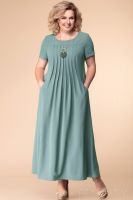 3.1. An example of calculating the consumption of fabric according to the finished pattern of a dress with a trapezoid on a yoke for sizes from 40 to 64
3.1. An example of calculating the consumption of fabric according to the finished pattern of a dress with a trapezoid on a yoke for sizes from 40 to 64
The pattern of this dress has a trapezoidal semi-adjacent silhouette with a relief on the back and a semi-relief on the shelf. This design allows you to more accurately fit the silhouette shape, achieving an elegant freedom of fitting.
The dress can be sewn, both with soft folds on the shelves, and without them. An additional pattern of a shelf without folds will allow you to check the accuracy of the folds or sew a dress without them from a denser fabric.The fabric consumption will be from 280 to 330 cm. If possible, buy fabrics 20-30 cm more for a practice sample of folds.
Download the pattern of this dress 40-64
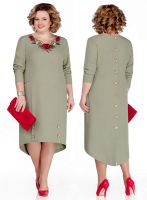 3.2. Fabric consumption for a sheath dress according to the finished pattern for sizes from 40 to 64
3.2. Fabric consumption for a sheath dress according to the finished pattern for sizes from 40 to 64
Most dense, but not too thick fabrics of the dress and suit range will do.
Dress wool, dense stretch with low stretch, linen, denim, heavy silk - all these fabrics are worth sewing a sheath dress.
The consumption with a long sleeve with a width of 140 cm will be from 190 to 260 cm, depending on the size of the dress.
Download pattern large size dress sheath
 3.3 Calculation of fabric consumption for an oversized dress according to the finished pattern
3.3 Calculation of fabric consumption for an oversized dress according to the finished pattern
The consumption for a combined dress will be 110 - 135 cm "plaid" and the same amount of "dark fabric". Consumption is calculated using the formula
One length + 10cm
Consumption for a plain dress will be from 150 to 230 cm with a width of 140 - 150 cm.
For sewing, you can choose any not too thin dress fabrics. This style is suitable for sewing both warm and summer dresses. This dress can be made from both stable and stretch fabrics. For example, dress wool and plaid, jersey, footer are ideal for a warm dress, and linen or denim is ideal for a summer dress. From stretch fabrics, it is better to choose dense fabrics with little or medium stretch.
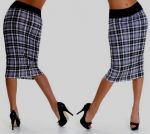
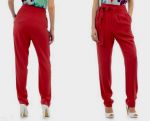

 Join my community on Viber...
Join my community on Viber...











